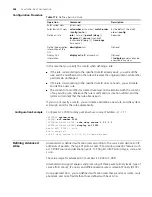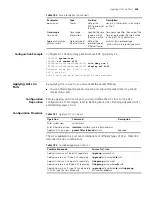
214
C
HAPTER
27: Q
O
S C
ONFIGURATION
■
RFC2474 re-defines the ToS field in the IP packet header, which is called the DS
field. The first six (bit 0-bit 5) bits of the DS field indicate DSCP precedence in the
range of 0 to 63.The first three bits in DSCP precedence are class selector
codepoints, bit 4 and bit 5 indicate drop precedence, and bit 6 is zero indicating
that the device sets the service class with the DS model.
■
The last two bits (bit 6 and bit 7) are reserved bits.
The precedence values of the IP packet indicate 8 different service classes.
The DiffServ network defines four traffic classes:
■
Expedited Forwarding (EF) class: In this class, packets can be forwarded regardless
of link share of other traffic. The class is suitable for preferential services with low
delay, low packet loss ratio, low variation and assured bandwidth (such as virtual
leased line);
■
Assured forwarding (AF) class: This class is further divided into four subclasses
(AF1/2/3/4) and a subclass is further divided into three drop priorities, so the AF
service level can be segmented. The QoS rank of the AF class is lower than that of
the EF class;
■
Class selector (CS) class: This class comes from the IP TOS field and includes 8
classes;
■
Best Effort (BE) class: This class is a special class without any assurance in the CS
class. The AF class can be degraded to the BE class if it exceeds the limit. Current IP
network traffic belongs to this class by default.
Table 184
Description on IP Precedence
IP Precedence
(decimal)
IP Precedence
(binary)
Description
0
000
routine
1
001
priority
2
010
immediate
3
011
flash
4
100
flash-override
5
101
critical
6
110
internet
7
111
network
Table 185
Description on DSCP values
Key word
DSCP value (decimal)
DSCP value (binary)
ef
46
101110
af11
10
001010
af12
12
001100
af13
14
001110
af21
18
010010
af22
20
010100
af23
22
010110
af31
26
011010
af32
28
011100
af33
30
011110
af41
34
100010
Summary of Contents for 4200G 12-Port
Page 10: ...8 CONTENTS...
Page 14: ...4 ABOUT THIS GUIDE...
Page 46: ...32 CHAPTER 5 LOGGING IN THROUGH WEB BASED NETWORK MANAGEMENT SYSTEM...
Page 48: ...34 CHAPTER 6 LOGGING IN THROUGH NMS...
Page 60: ...46 CHAPTER 9 VLAN CONFIGURATION...
Page 64: ...50 CHAPTER 10 MANAGEMENT VLAN CONFIGURATION...
Page 80: ...66 CHAPTER 13 GVRP CONFIGURATION...
Page 98: ...84 CHAPTER 15 LINK AGGREGATION CONFIGURATION...
Page 112: ...98 CHAPTER 18 MAC ADDRESS TABLE MANAGEMENT...
Page 126: ...112 CHAPTER 19 LOGGING IN THROUGH TELNET...
Page 162: ...148 CHAPTER 20 MSTP CONFIGURATION...
Page 274: ...260 CHAPTER 29 IGMP SNOOPING CONFIGURATION...
Page 276: ...262 CHAPTER 30 ROUTING PORT JOIN TO MULTICAST GROUP CONFIGURATION...
Page 298: ...284 CHAPTER 33 SNMP CONFIGURATION...
Page 304: ...290 CHAPTER 34 RMON CONFIGURATION...
Page 338: ...324 CHAPTER 36 SSH TERMINAL SERVICES...
Page 356: ...342 CHAPTER 38 FTP AND TFTP CONFIGURATION...
Page 365: ...Information Center Configuration Example 351 S4200G terminal logging...
Page 366: ...352 CHAPTER 39 INFORMATION CENTER...
Page 378: ...364 CHAPTER 40 BOOTROM AND HOST SOFTWARE LOADING...
Page 384: ...370 CHAPTER 41 Basic System Configuration and Debugging...
Page 388: ...374 CHAPTER 43 NETWORK CONNECTIVITY TEST...
Page 406: ...392 CHAPTER 45 CONFIGURATION OF NEWLY ADDED CLUSTER FUNCTIONS...
















































